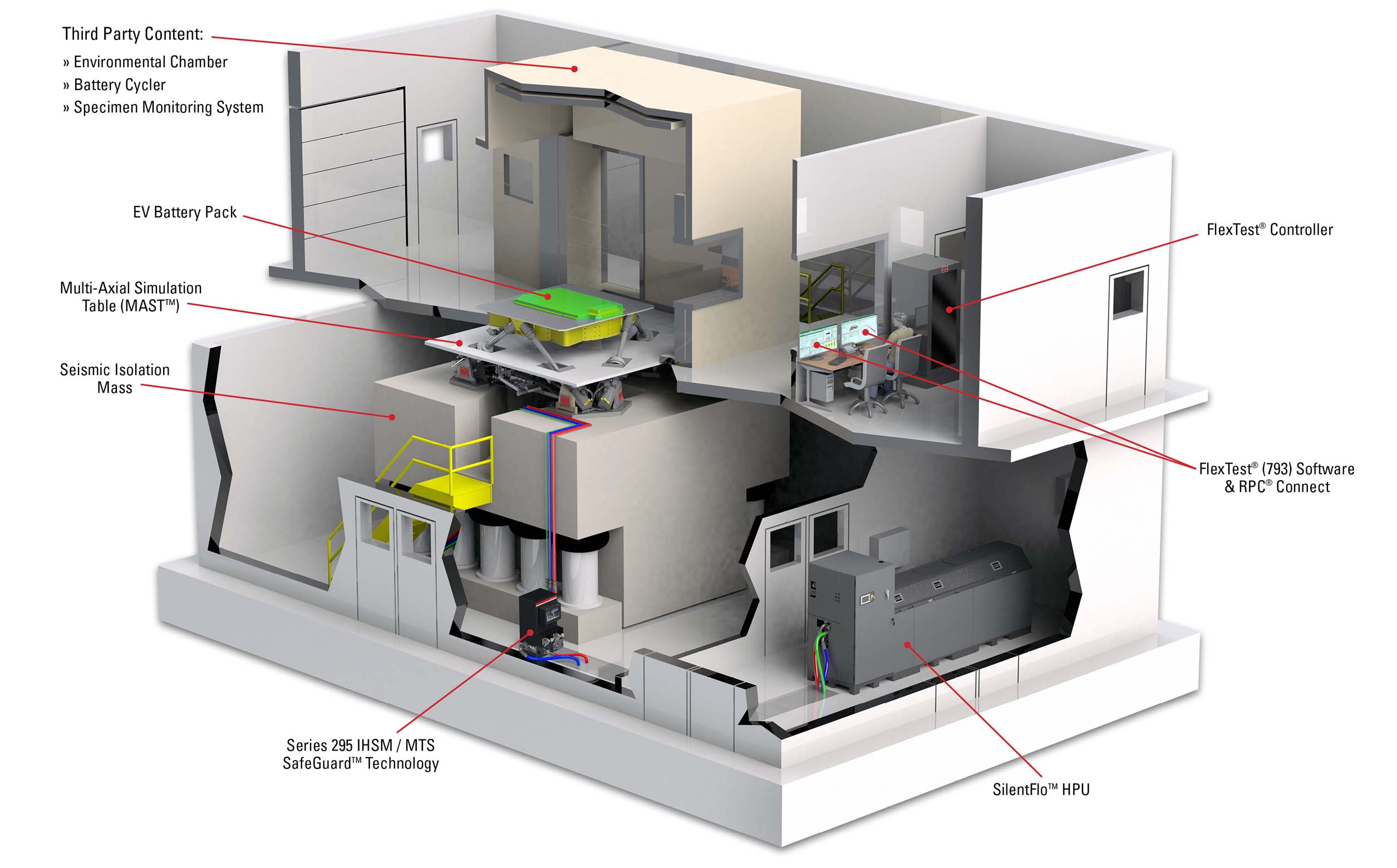EV 배터리 테스트 애플리케이션
전기 자동차, 트럭, 오프하이웨이 차량, 자전거, 스쿠터 및 전지형 차량(ATV)용 리튬 이온 배터리 및 배터리 팩의 내구성, 성능, 신뢰성 및 품질을 검증하세요.Technical Overview
전 세계적인 탄소 배출 제로 전기차 트렌드는 리튬 이온 배터리에 대한 포괄적인 수명 주기 테스트에 대한 긴급한 수요를 촉진하고 있습니다. 리튬 이온 배터리는 이러한 새로운 차량의 지속적인 주행 가능성을 확보하는 데 필수적입니다. 이 테스트는 공급업체, OEM 및 계약 테스트 연구소에서 수행하며, 실제 진동 현상에 노출될 때 리튬 이온 배터리 팩의 내구성, 성능, 품질 및 안전성을 검증하는 것을 목표로 합니다.
테스트 방법
리튬 이온 배터리 진동 테스트 프로필은 ISO 12405를 비롯한 다양한 국제 표준 또는 배터리 공급업체 및 OEM에서 결정한 기준에 따라 지정됩니다. 테스트는 리튬 이온 배터리, 배터리 팩 또는 차량 섀시에 장착된 배터리 팩을 환경 챔버 내에 통합된 진동 테이블에 고정하고, 배터리 사이클링 및 시편 모니터링 기술을 활용하여 수행됩니다. 진동은 세 가지 공간 방향으로 순차적으로 적용되며, 먼저 수직(Z) 방향, 그다음 가로(Y) 방향, 마지막으로 세로(X) 방향으로 진행됩니다. 진동 테스트 과정에서는 온도 프로필이 중첩 적용되며, 시편의 파손 및 전기 접촉 손실 여부를 모니터링합니다. 기타 리튬 이온 배터리 테스트 표준으로는 SAE J2380, UN R100, UN R136, UN 38.3 등이 있습니다.
테스트 결과
배터리 공급업체, OEM 및 계약 테스트 연구소는 다양한 목적으로 진동 테스트 결과를 활용합니다. 여기에는 배터리의 내구성과 예상 수명을 평가 및 검증하는 것, 다양한 환경 조건에서 배터리의 진동 전달 특성, 성능 및 신뢰성을 특성화하는 것, 그리고 제조된 배터리가 엄격한 품질 기준을 준수하는지 확인하는 최종 검사(end-of-line testing)가 포함됩니다.
MTS 제품 솔루션
-
다축 시뮬레이션 테이블(MAST) 시스템은 국제 배터리 테스트 표준을 준수할 수 있도록 고주파수 및 대형 하중 및 형상을 처리할 수 있는 표준 및 맞춤형 구성으로 제공됩니다. 6자유도(DOF) MAST 시스템은 타사 환경 챔버, 배터리 사이클러 및 시편 모니터링 시스템과 원활하게 통합되도록 설계되었습니다.
- RPC Connect 소프트웨어는 테스트 연구소의 효율성과 처리량을 최적화하도록 설계되었습니다. 이 소프트웨어는 필드에서 측정한 도로 하중을 기계적 테스트 장치에서 정확하고 효율적으로 재현할 수 있도록 하여, 실제 도로 검증을 통제되고 반복 가능한 실험실 환경으로 가져올 수 있습니다.
-
FlexTest 컨트롤러는 고속 폐쇄 루프 제어, 기능 생성, 변환기 조정 및 데이터 수집 기능을 제공합니다. FlexTest(793) 소프트웨어의 고급 보상 도구인 자유도(Degree-of-Freedom) 제어, 세 변수(Three-Variable) 제어, 진폭-위상(Amplitude Phase) 제어 및 적응형 고조파 제거(Adaptive Harmonic Cancelation)를 통해 MAST 시스템의 제어성과 충실도를 극대화할 수 있습니다.
-
Series 295 Isolation 유압 서비스 매니폴드(ISHM)/MTS SafeGuard™ 기술은 ISO 13849에 따른 지역별 안전 성능 수준(PLc, PLd, PLe)을 충족하도록 유압 시스템의 예측 가능한 제어 기능을 향상시키고 고급 안전 기능을 구현합니다.
-
SilentFlo™ 515 유압 동력 장치(HPU)는 최첨단 모터 및 냉각 회로를 갖추어 고도로 신뢰할 수 있으며 에너지 효율적인 유압 동력을 생성합니다. SilentFlo HPU는 부품 수를 줄이고, 컨트롤을 쉽게 접근할 수 있도록 하며, 향상된 필터링 기능을 제공하여 사용 및 유지보수가 용이합니다.


